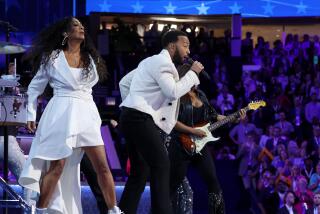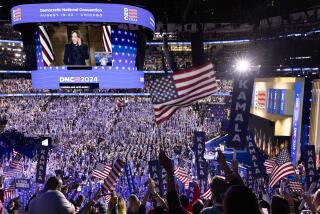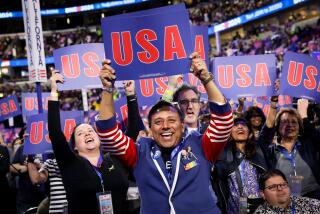Obama pledges Greek
In 1960, after John F. Kennedy decided to move his convention acceptance speech from the brand-new Sports Arena to the larger Los Angeles Memorial Coliseum next door, he addressed a crowd of 80,000 from a stage that seen through 21st century eyes looks innocent and modest, if not clumsy. On the front of the lectern, just beneath the microphones, was a simple sign, its capital letters as skinny as Kennedy’s tie, reading “Democratic National Convention.” Below that, a large painted eagle spread its wings.
American political stagecraft is more cunning and aggressive these days. During the last eight years, George W. Bush and his top set dresser, the former ABC producer Scott Sforza, teamed up to produce a number of multimedia backdrops mixing Orwellian message control with enough bunting to fill Omaha.
But even the most dedicated member of the Bush White House would have to admit the boldness -- the weird, allusive, surprising boldness -- of the set built for Barack Obama’s speech Thursday night inside Denver’s Invesco Field. Not content with a basic combination of video screens and slogans, Obama’s campaign produced a full-on neoclassical temple facade: four imposing Doric columns and 10 sizable pilasters, all connected by a frieze and arranged in a gently curving arc. From the center of this colonnaded contraption extended a long peninsular walkway, lined with blue carpeting and capped by a circular stage and wedding-cake steps. Like a nervous parent dropping a child off at school, the set seemed to protect Obama and push him forward at the same time.
John McCain’s advisors were quick to ridicule the setup as overblown, reflective of Obama’s generous self-regard. The Washington Post’s Dana Milbank, who got an up-close look, noted that “the columns turned out to be made of drywall and laminated plywood.”
Still, however oddly Athenian the whole thing seemed at first glance on television, the set did manage to distract viewers’ attention from the gigantic scale of the stadium. The Obama campaign made the decision to move the acceptance speech from the indoor Pepsi Center to the 76,000-seat Invesco Field months ago. That was well before Obama’s European tour left him vulnerable to charges that he is a rock-star candidate who loves to soak up cheers from adoring crowds.
If his advisors felt they couldn’t move the speech out of the stadium, however, they apparently realized they could at least make the stadium look less like itself. The set managed to bring this 2001 structure -- designed by the Kansas City firm HNTB Architects in a sleek, ornament-free style -- down to size.
Classicism offers an almost bottomless pool of symbolism, and the campaign dipped into it with a number of goals. For an American viewer, a row of columns can suggest stability or even martial strength, which may have appealed to counselors eager to use Thursday’s speech to take on charges that their candidate is soft on national security. Such columns can also suggest populism and public participation -- the highest-minded ideals of democratic government.
Obama clearly wanted to forge a link to the 1960 Kennedy appearance, which conveniently enough took place inside a neoclassical stadium. Even more obvious was the way the four big columns -- two on either side of the stage, framing a pair of video screens -- and the frieze suggested the imposing facade of Henry Bacon’s Lincoln Memorial, where Martin Luther King Jr. gave his “I Have a Dream” speech 45 years to the day before Obama’s address.
Nearly as impossible to miss were the set’s visual connections to the White House. The false windows in the center were clearly meant to suggest those at 1600 Pennsylvania Ave. They were warmly illuminated, suggesting that a family was at home -- Obama’s. When his wife and daughters emerged to greet the candidate at the end of his address, they came out from behind those windows. On the whole, the set tried to do what the White House itself does better than most architectural symbols: strike a balance between grand, imposing touches and approachable, domestic scale.
The set also offered fainter allusions, including some to Soldier Field, not far from where the Obama family lives on the south side of Chicago. Completed in 1928 -- six years after the Lincoln Memorial -- the stadium was designed by the Chicago firm Holabird & Root in a full-throated, somewhat militaristic neoclassical style. It was updated rather controversially in 2003, with architects Ben Wood and Carlos Zapata dropping a modern, steel-and-glass seating bowl inside.
Obama’s strategists essentially did the reverse, inserting a neoclassical backdrop into a steel-and-glass stadium. That meant they were moving against the grain of history, a fact that produced the most jarring meeting of the night between visuals and rhetoric. When Obama, near the end of his speech, declared, “America, we cannot turn back” and then repeated the line for emphasis, I found myself thinking about those columns and their echoes of the deep architectural past -- about how they were employed primarily to suggest time rolling backward all the way to the Greeks. Somehow, for Obama, a candidate whose campaign is sleek and modern in the same way Kennedy’s was -- whose appeal is based in large part on his youthful energy and the freshness of his image -- sleek and modern architectural symbolism simply will not do. His charisma needs some balancing heft, and in Denver his campaign found it in the solidity of classical architecture.
The set thus seemed a preview of the way his campaign will proceed. He seems unlikely to jettison the change mantra altogether: It has been too effective. But if the Denver stage design was any indication, once the summer is officially over he may start using the language -- and the symbolism -- of tradition and reassurance a good deal more than we’ve seen so far.
--
christopher.hawthorne@latimes.com
More to Read
The biggest entertainment stories
Get our big stories about Hollywood, film, television, music, arts, culture and more right in your inbox as soon as they publish.
You may occasionally receive promotional content from the Los Angeles Times.











